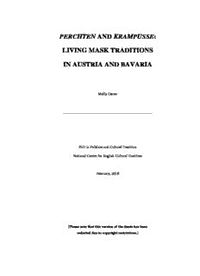Table Of ContentPERCHTEN AND KRAMPUSSE:
LIVING MASK TRADITIONS
IN AUSTRIA AND BAVARIA
Molly Carter
________________________________________________
PhD in Folklore and Cultural Tradition
National Centre for English Cultural Tradition
February, 2016
(Please note that this version of the thesis has been
redacted due to copyright restrictions.)
1
2
DEDICATION
To my parents, Joseph and Nancy Carter, Garth Powell,
and the Perchten and Krampusse of Austria and Bavaria.
3
4
ABSTRACT
Two centuries-old mask traditions native to Austria and Bavaria enjoy ongoing popularity
due to a creative mingling of old and new elements (heavy metal music and fireworks
alongside hand-carved wooden masks and birch rod switches). The Krampus is the
menacing companion of St. Nikolaus, who visits children on December 5 and 6, although
nowadays groups of Krampusse may appear alone. The Perchten, who are associated with
the magical female folk-figure Perchta, appear on January 5 and the week before. While the
Perchten and Krampusse represent distinct traditions, their history has intersected at various
points, and their contemporary manifestations share many elements, including a movement
towards a “modern” aesthetic and the employment of such resources as tourist publicity and
the internet to promote their appearances, educate the public, and network with each other.
While the house visit was formerly the primary setting for these masked figures (or
mummers), today it is the public parade. These parades, while rooted in and resembling
conventional display-custom performances marked by a static division between performer
and spectator, actually consist of a kind of fluid, interactive ritual theater in which the
partially improvised, partially scripted performances of masked figures and the responses of
spectators shape one another. Contemporary manifestations of Perchten and Krampus
traditions will be explored in light of the ongoing cultural dialogue between performers and
non-performers who seek to define and interpret the tradition, and the interplay of academic
and popular discourses surrounding invented tradition, Folklorismus (folklorism) and
Rücklauf (feedback), and the nature of authenticity. Questions of cultural heritage
“ownership” surface in the debates over form and meaning, while in the hands of the
Perchten and Krampusse themselves, tradition emerges as an active process and
collaborative artwork rather than a fixed commodity with boundaries which can be defined
and navigated by outside observers.
5
6
ACKNOWLEDGEMENTS
I am profoundly grateful to the Overseas Research Committee, whose generous scholarship
funded the first three years of my research and made it possible for me to complete this
work; my advisors, Dr. Joan Beal and Dr. Malcolm Jones of the National Centre for English
Cultural Tradition at the University of Sheffield; Garth Powell for support of all kinds,
including help with editing and proofreading; Dr. Maria Darcy; Erika Strenski, Markus
Lessmann, Sarina Stützer, and Cynthia Dyre-Moellenhof for advice regarding German
translation issues; Silvia Lenglachner for acting as my interpreter for my initial interview
with the Salzburger Schiachpercht’n; Joe Anzenberger for help with audio and visual
materials; and Veronika Pichler of Institut St. Sebastian in Salzburg for rescuing my field
recordings from loss in transit and for providing a home base in the field. Thanks also go to
Emily Lyle and the members of the SIEF Working Group on the Ritual Year, whose
comments on work in progress helped me to refine my ideas and shape a sprawling project
into what I hope is a coherent whole.
Most importantly, I owe a tremendous debt of gratitude to all of the Perchten and
Krampusse who generously gave of their time to help me come closer to seeing these
traditions through their eyes and understand their motivations for carrying them forward
into the twenty-first century, especially Günter Polanec of the Salzburger Schiachpercht’n
of Salzburg and Sonja Edlinger of the Thomasnikolo group of Gams bei Hieflau, Styria,
whose friendship and generosity transformed this task into a true labor of love.
7
8
TABLE OF CONTENTS
GLOSSARY OF TERMS AND NOTES ON THE LANGUAGE 1
Place Names 6
Words Commonly Used to Describe Perchten and Krampusse 7
General Notes on Translation 7
Mumming Defined 8
A Note on the Video Appendix 10
1. CONTEMPORARY PERCHTEN AND KRAMPUSSE: AN INTRODUCTION 11
1.1 Overview of the People and Place 11
1.2 Perchten Defined 14
1.3 Krampusse Defined 16
1.4 Distinctions between Perchten and Krampusse 17
1.5 Shared Characteristics 19
1.5.1 Testing Grounds for Notions of Continuity, Tradition, and Authenticity 19
1.5.2 The Juxtaposition of Antiquity and Modernity 20
1.5.3 Stewardship of Cultural Heritage and Issues of Authority 21
1.5.4 Continuing Cultural Relevance 21
1.5.5 The Incorporation of New Technologies 22
1.5.6 Popularity, Tourism, and Self-Promotion 23
1.5.7 Aesthetic Evolution 23
1.5.8 The Redefinition of Boundaries and Identity 24
1.5.9 Rewards and Punishments 24
1.5.10 The Performance-Encounter 25
1.6 Performance Forms and Settings 25
1.6.1 The Procession 26
1.6.2 The Free Run (Freilauf) 27
1.6.3 The House Visit (Einkehrbrauch) 28
1.6.4 The Leaving of Gifts (Einlegenbrauch) 28
1.6.5 The Catechism-Interrogation (Katechese) 29
1.6.6 The Krampuskränzchen (“Krampus-Gathering”) 30
1.6.7 Dances and Hellshows 31
1.6.8 The Nikolaus Play 31
9
1.6.9 Mask Exhibitions (Maskenaustellungen) and Kinderkrampusstreichelzoos (Children’s
Krampus Petting Zoos) 32
1.6.10 Perchten and Krampus Group Websites 33
1.7 Thesis Overview 34
2. METHODOLOGICAL ISSUES 36
2.1 Defining the Subject 36
2.2 Research Questions and Objectives 39
2.3 Research Design and Preparation 41
2.4 Fieldwork Methodologies 42
2.4.1 Participant-Observation 42
2.4.2 Conducting Interviews 44
2.4.3 Collecting Ephemera 46
2.5 Outsider Identity: Challenges and Opportunities 47
2.5.1 Culture 47
2.5.2 Language 48
2.5.3 Gender 49
2.6 The Ethnographer/Field Subject Relationship 50
3. LITERATURE REVIEW 53
3.1 Early Volkskunde and the Continuity Problem 53
3.2 The Second Wave: National Socialist Volkskunde 57
3.3 The Third Wave: Restoring Historicity 60
3.4 Mummers in their Own Words 68
4. PERCHTA AND PERCHTEN: ORIGINS AND IDENTITY 71
4.1 The Meaning of the Name “Percht” and Name Variations 72
4.2 A Typology of Perchta References 74
4.3 Butzenbercht and Kinderfresser: Early Mumming Evidence? 75
4.4 Perchten Mumming from 1550 to 1900 80
4.4.1 The Criminalization of the Perchtenlauf 81
10

